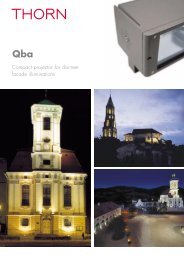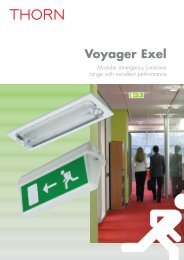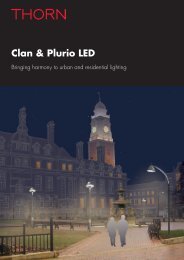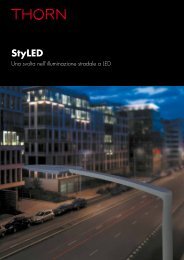Download LED Lighting Brochure - THORN Lighting
Download LED Lighting Brochure - THORN Lighting
Download LED Lighting Brochure - THORN Lighting
- No tags were found...
Create successful ePaper yourself
Turn your PDF publications into a flip-book with our unique Google optimized e-Paper software.
<strong>LED</strong> Technology and ControlProgress in <strong>LED</strong> TechnologyDespite its extensive use for more than40 years the light-emitting diode (<strong>LED</strong>)remains a mystery to its millions of users –the majority of whom have long taken forgranted these small light sources that seemto exist in almost every electronic device,from clock radios to traffic lights.Even those sufficiently informed torealise that an <strong>LED</strong> is a solid-statesemiconductor device that emitslight when an electric currentpasses through it probably onlyknow a few of the attributesthat contribute to one of mostremarkable growth patterns thelighting world has ever known.Following the development ofa new generation of materials,particularly over the last decade,and quite apart from continuedimprovements in brightness, life,colour quality and the range ofshapes and sizes, the efficacy ofcurrent <strong>LED</strong>s for general lightingare now above 100 Lm/Wcompared to the limited redindicator of the late 1960s andits useful life has been extendedto around 50,000 hours. Inshort, it is now considered amainstream lighting technology.How they workThe <strong>LED</strong> consists of a diode chip(or die) made of semiconductingmaterial, encased within anepoxy, plastic, resin or ceramichousing and attached to theelectrical circuit. This housingmay be in a variety of shapesand sizes and helps determinethe optical characteristics of the<strong>LED</strong>. Generally a second opticalcontroller is used in the form ofa lens mounted on the epoxyhousing.As well as the optical controlof the system, designing using<strong>LED</strong>s requires careful thermalmanagement. Whilst the ratioof light to heat produced by<strong>LED</strong>s is much higher than for anincandescent lamp they do stillproduce a significant amount ofheat. As <strong>LED</strong>s do not emit heatas infrared radiation (IR) – thelight beam is cool - the heat mustbe removed from the device byconduction or convection. Withoutadequate heat sinking or activecooling, the junction temperatureof the internal diode will rise,shortening lifetimes.Finally, to operate <strong>LED</strong>s requiresa regulated direct current supply,usually supplied by a self-contained“driver” which converts the ACmains electricity to the correctDC voltage. This driver must becorrectly matched to the <strong>LED</strong> itis powering as incorrect voltageand current will at best providepoor light, and may severelyreduce the life of the <strong>LED</strong> or causeinstantaneous failure of the system.The driver can provide a quiteadvanced level of control, allowingdimming down to 0%, and with acluster of different coloured diodesand the use of technology suchas DMX protocols linked to a lightmixing console extremely complexlighting effects may be produced.So the <strong>LED</strong> is not a true “lamp”,generally being supplied as acomplete electrical and opticalsystem, which is then embodiedinto a housing – hence the term“solid state lighting” as thelight is emitted from a block ofsemiconductor material rather thanfrom a vacuum or gas enclosure.A typical <strong>LED</strong> light engine consists of singleor multiple <strong>LED</strong>s placed on a printed circuitboard in a variety of shapes and sizes.Shown is a circular configuration.Photo courtesy: Ledon <strong>Lighting</strong>.Today, the most popular type of <strong>LED</strong> forprofessional lighting is the surface mounteddevice (SMD). SMD <strong>LED</strong>s are individualsurface-soldered standard products, whichare ready encapsulated.Photo courtesy: Cree, Inc.38


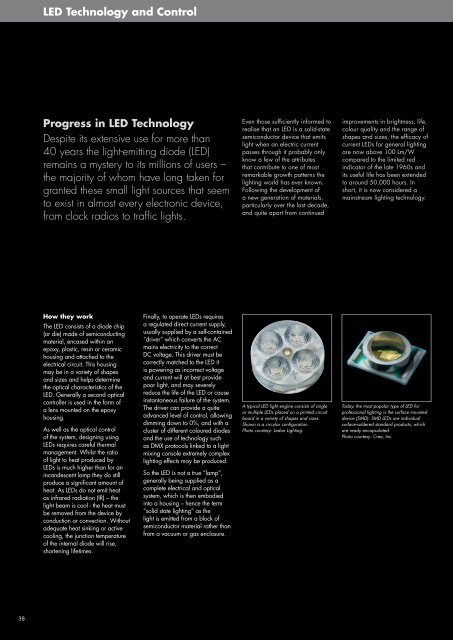
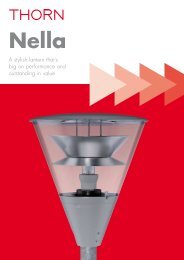
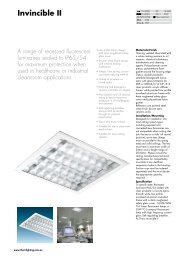
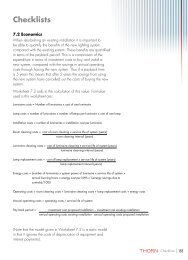
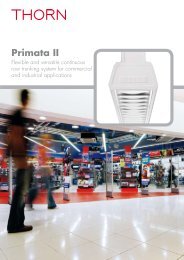
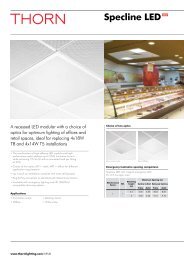

![Produkt brochure [PDF/4MB] - THORN Lighting](https://img.yumpu.com/50705283/1/184x260/produkt-brochure-pdf-4mb-thorn-lighting.jpg?quality=85)
